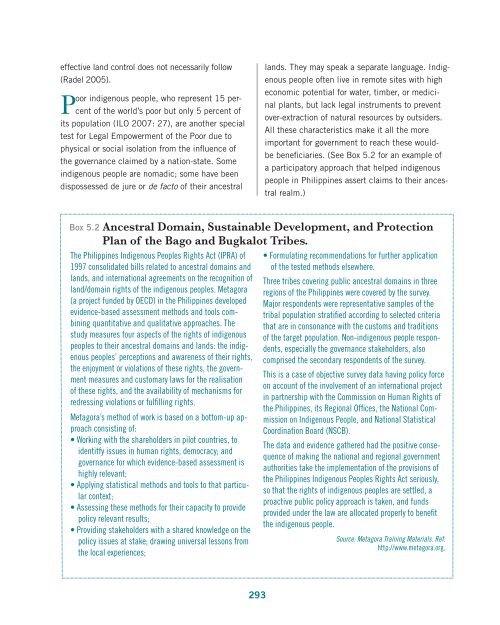Download the file - United Nations Rule of Law
Download the file - United Nations Rule of Law
Download the file - United Nations Rule of Law
Create successful ePaper yourself
Turn your PDF publications into a flip-book with our unique Google optimized e-Paper software.
effective land control does not necessarily follow(Radel 2005).Poor indigenous people, who represent 15 percent<strong>of</strong> <strong>the</strong> world’s poor but only 5 percent <strong>of</strong>its population (ILO 2007: 27), are ano<strong>the</strong>r specialtest for Legal Empowerment <strong>of</strong> <strong>the</strong> Poor due tophysical or social isolation from <strong>the</strong> influence <strong>of</strong><strong>the</strong> governance claimed by a nation-state. Someindigenous people are nomadic; some have beendispossessed de jure or de facto <strong>of</strong> <strong>the</strong>ir ancestrallands. They may speak a separate language. Indigenouspeople <strong>of</strong>ten live in remote sites with higheconomic potential for water, timber, or medicinalplants, but lack legal instruments to preventover-extraction <strong>of</strong> natural resources by outsiders.All <strong>the</strong>se characteristics make it all <strong>the</strong> moreimportant for government to reach <strong>the</strong>se wouldbebeneficiaries. (See Box 5.2 for an example <strong>of</strong>a participatory approach that helped indigenouspeople in Philippines assert claims to <strong>the</strong>ir ancestralrealm.)Box 5.2 Ancestral Domain, Sustainable Development, and ProtectionPlan <strong>of</strong> <strong>the</strong> Bago and Bugkalot Tribes.The Philippines Indigenous Peoples Rights Act (IPRA) <strong>of</strong>1997 consolidated bills related to ancestral domains andlands, and international agreements on <strong>the</strong> recognition <strong>of</strong>land/domain rights <strong>of</strong> <strong>the</strong> indigenous peoples. Metagora(a project funded by OECD) in <strong>the</strong> Philippines developedevidence-based assessment methods and tools combiningquantitative and qualitative approaches. Thestudy measures four aspects <strong>of</strong> <strong>the</strong> rights <strong>of</strong> indigenouspeoples to <strong>the</strong>ir ancestral domains and lands: <strong>the</strong> indigenouspeoples’ perceptions and awareness <strong>of</strong> <strong>the</strong>ir rights,<strong>the</strong> enjoyment or violations <strong>of</strong> <strong>the</strong>se rights, <strong>the</strong> governmentmeasures and customary laws for <strong>the</strong> realisation<strong>of</strong> <strong>the</strong>se rights, and <strong>the</strong> availability <strong>of</strong> mechanisms forredressing violations or fulfilling rights.Metagora’s method <strong>of</strong> work is based on a bottom-up approachconsisting <strong>of</strong>:• Working with <strong>the</strong> shareholders in pilot countries, toidentitfy issues in human rights, democracy; andgovernance for which evidence-based assessment ishighly relevant;• Applying statistical methods and tools to that particularcontext;• Assessing <strong>the</strong>se methods for <strong>the</strong>ir capacity to providepolicy relevant results;• Providing stakeholders with a shared knowledge on <strong>the</strong>policy issues at stake; drawing universal lessons from<strong>the</strong> local experiences;• Formulating recommendations for fur<strong>the</strong>r application<strong>of</strong> <strong>the</strong> tested methods elsewhere.Three tribes covering public ancestral domains in threeregions <strong>of</strong> <strong>the</strong> Philippines were covered by <strong>the</strong> survey.Major respondents were representative samples <strong>of</strong> <strong>the</strong>tribal population stratified according to selected criteriathat are in consonance with <strong>the</strong> customs and traditions<strong>of</strong> <strong>the</strong> target population. Non-indigenous people respondents,especially <strong>the</strong> governance stakeholders, alsocomprised <strong>the</strong> secondary respondents <strong>of</strong> <strong>the</strong> survey.This is a case <strong>of</strong> objective survey data having policy forceon account <strong>of</strong> <strong>the</strong> involvement <strong>of</strong> an international projectin partnership with <strong>the</strong> Commission on Human Rights <strong>of</strong><strong>the</strong> Philippines, its Regional Offices, <strong>the</strong> National Commissionon Indigenous People, and National StatisticalCoordination Board (NSCB).The data and evidence ga<strong>the</strong>red had <strong>the</strong> positive consequence<strong>of</strong> making <strong>the</strong> national and regional governmentauthorities take <strong>the</strong> implementation <strong>of</strong> <strong>the</strong> provisions <strong>of</strong><strong>the</strong> Philippines Indigenous Peoples Rights Act seriously,so that <strong>the</strong> rights <strong>of</strong> indigenous peoples are settled, aproactive public policy approach is taken, and fundsprovided under <strong>the</strong> law are allocated properly to benefit<strong>the</strong> indigenous people.Source: Metagora Training Materials. Ref:http://www.metagora.org.293
















